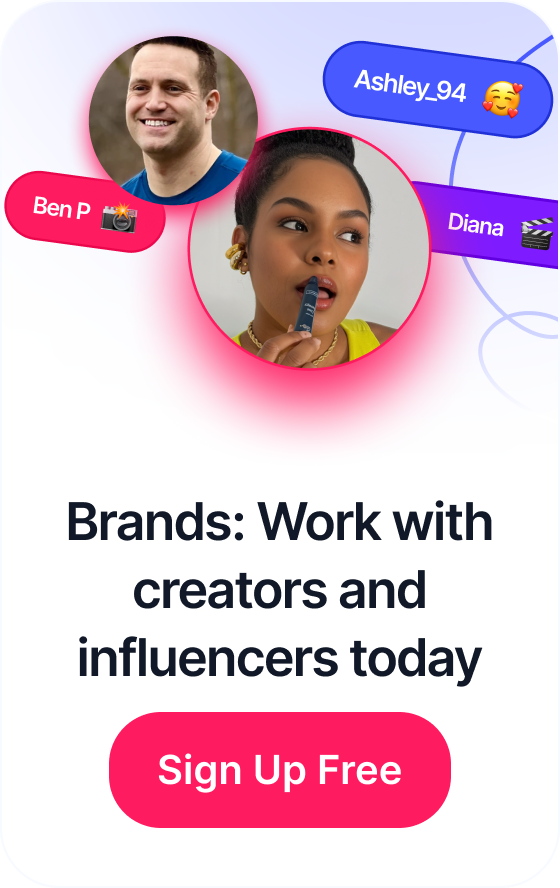 Your 2025 Social Media Holiday Calendar: 9 Unmissable Dates
Your 2025 Social Media Holiday Calendar: 9 Unmissable Dates
Table of Contents
Why User-Generated Content Matters Now More Than Ever
Want to build trust, boost engagement, and drive sales? This listicle reveals eight key benefits of user-generated content (UGC) and why it's essential for marketing success. Learn how UGC offers cost-effective content creation, improves SEO performance, enhances customer loyalty, and provides valuable market research insights. Discover how leveraging the power of UGC can elevate your brand and increase conversions.
1. Authenticity and Trust Building
In today's digital landscape, consumers are bombarded with marketing messages, making it harder than ever to cut through the noise and build genuine connections. This is where the power of user-generated content (UGC) shines. UGC provides authentic perspectives from real customers, fostering a sense of transparency and honesty often missing in traditional marketing. When potential customers see real people using and endorsing products or services, they're more likely to trust the brand than polished corporate messaging. This organic, peer-to-peer validation is a cornerstone of successful modern marketing strategies and a key benefit of user-generated content.

UGC comes in many forms, including unfiltered customer opinions and experiences, peer recommendations, raw, unedited photos and videos reflecting genuine user experiences, and any content created by actual users of products/services. This genuine content resonates more deeply with audiences. Instead of hearing a brand tell them how great a product is, they see and hear it directly from someone they can relate to. Recent studies show that UGC increases brand credibility by a staggering 92%. This isn't just about boosting sales; it's about cultivating lasting relationships built on trust. UGC creates an emotional connection between brands and audiences, reducing skepticism toward marketing messages and establishing crucial social proof for products and services.
Consider GoPro's Instagram feed, brimming with customer-captured adventure videos. These breathtaking visuals aren't slick corporate productions; they're raw, authentic glimpses into how real people use their products. Similarly, Airbnb leverages customer reviews and property photos, painting a much more realistic picture of a potential stay than any professionally staged photoshoot ever could. Glossier, a beauty brand built on UGC, regularly reposts customer selfies showcasing their products, creating a community around shared experiences. These examples demonstrate the power of authenticity in building trust and driving engagement.
While the benefits are compelling, UGC also presents challenges. Quality and professionalism can vary widely, and there's always the potential for negative content that could damage brand reputation. Brands also relinquish some control over messaging and brand positioning. However, with careful planning and execution, the rewards far outweigh the risks.
To effectively leverage UGC for authenticity and trust building, consider these tips:
- Highlight and showcase the most authentic customer content: Feature the real, unpolished gems that showcase genuine user experiences.
- Respond to user content: Acknowledge and validate contributors, fostering a sense of community.
- Create specific hashtags: Encourage customers to share their experiences using branded hashtags, making it easier to find and curate content.
- Balance curating high-quality UGC while maintaining authenticity: Find the sweet spot between showcasing polished content and preserving the genuine, unedited feel that makes UGC so impactful.
Campaigns like Starbucks' White Cup Contest, Apple's #ShotOniPhone campaign, and Coca-Cola's "Share a Coke" campaign have popularized and demonstrated the immense power of UGC. These initiatives tapped into the creative energy of their customer base, generating massive brand awareness and engagement.
For businesses of all sizes, from DTC and e-commerce brands to established enterprises, UGC offers a powerful way to connect with audiences on a deeper level. Whether you're a startup launching a new product, a social media manager crafting engaging campaigns, or a CMO overseeing brand strategy, understanding and implementing UGC is crucial in today's competitive market. Learn more about Authenticity and Trust Building to delve deeper into strategies for identifying and collaborating with micro-influencers, another powerful source of authentic content. By embracing the power of real voices and experiences, you can build a brand that resonates with authenticity, fosters trust, and ultimately drives lasting success.
2. Cost-Effective Content Creation
One of the most compelling benefits of user-generated content (UGC) is its cost-effectiveness. For DTC and e-commerce brands, as well as marketing agencies and in-house social media managers, UGC dramatically reduces the costs associated with content production. By leveraging the creativity and enthusiasm of your customer base, you can acquire a diverse range of high-quality content without the hefty expenses typically associated with professional photography, videography, or copywriting. This approach transforms customers from passive consumers into active brand advocates and content creators, enriching your marketing ecosystem and saving you valuable budget. Instead of relying solely on internal resources or expensive external agencies, you can tap into a wellspring of authentic content ready to be shared. This is especially valuable for startups, product launch teams, and smaller brands looking to compete with larger companies through content volume and reach.

UGC offers several key features that contribute to its cost-effectiveness: content created at little to no direct cost to the company; scalable content creation that grows organically with your user base; a diverse range of content formats, from photos and videos to written testimonials and reviews; and a continuous flow of fresh content without rigid production scheduling. This organic content creation model allows brands to maintain a vibrant online presence without the constant pressure of generating new material from scratch.
Pros:
- Reduces content creation costs by up to 30-50%: Reallocate budget towards other marketing initiatives.
- Provides a constant stream of fresh content without production delays: Maintain an active and engaging online presence.
- Decreases reliance on expensive professional content creators: Diversify your content sources.
- Allows smaller brands to compete with larger ones through content volume: Level the playing field through authentic user-generated content.
Cons:
- Possible inconsistency in quality and branding: Implement clear guidelines and moderation processes to maintain consistency.
- May require moderation resources to filter inappropriate content: Allocate resources for content review and approval.
- Less control over artistic direction and messaging: Balance creative control with the authenticity of user-generated content.
Examples of Successful Implementation:
- Buffer: Uses customer success stories and testimonials instead of creating case studies from scratch.
- Wayfair: Features customer photo galleries of furnished rooms, showcasing their products in real-life settings.
- Lululemon: Leveraged the #thesweatlife campaign featuring customers wearing their activewear, creating a strong sense of community and brand affinity.
Tips for Effective UGC Implementation:
- Create clear submission guidelines: Encourage high-quality content that aligns with your brand.
- Offer simple incentives like feature spotlights to motivate participation: Recognize and reward your contributing customers.
- Develop easy ways for users to submit content through apps or social media: Streamline the submission process.
- Implement efficient moderation processes to quickly approve and publish content: Maintain a consistent flow of fresh UGC.
Popularized By:
- Adobe: User-created tutorials and templates contribute to a vast library of resources.
- LEGO Ideas: A platform for user-designed LEGO sets, some of which are selected for production.
- Doritos: "Crash the Super Bowl" contest, a prime example of successful UGC marketing campaigns.
Leveraging UGC offers a significant advantage in today’s content-saturated digital landscape. This cost-effective approach allows brands of all sizes, from SaaS founders and CPG startups to established enterprise companies, to build authentic connections with their audience, foster brand loyalty, and achieve substantial cost savings. By incorporating user-generated content into your marketing strategy, you can tap into the power of your community and significantly enhance your content marketing efforts. This strategy is particularly beneficial for anyone involved in digital marketing, advertising, social media management, and brand building, including CMOs, Directors of Marketing, and influencer marketing professionals.
3. Improved SEO Performance
User-generated content (UGC) is a powerful tool for boosting your search engine optimization (SEO). It works by leveraging the authentic language and diverse perspectives of your audience to enhance your website's visibility and ranking in search results. When users create content related to your brand, products, or services, they naturally incorporate a wider range of keywords and phrases than you might typically use in your own marketing materials. This organic incorporation of long-tail keywords and conversational phrases is invaluable for capturing the nuances of how potential customers search. Furthermore, the constant influx of fresh content signals to search engines that your site is active and relevant, improving your site freshness score. Finally, the increased dwell time and engagement metrics resulting from user interaction with authentic peer content are strong indicators of quality content, which search engines value.

This approach deserves a prominent place on the list of benefits of user-generated content due to its significant impact on organic search visibility. Features like the natural inclusion of long-tail keywords, the constant addition of fresh content, and the generation of additional indexed pages through reviews, comments, and forums all contribute to a stronger SEO profile. This translates into several key advantages, including increased organic search visibility for a wider variety of search queries, the creation of fresh content without dedicated SEO resources, improved click-through rates with authentic preview snippets, and reduced bounce rates as users engage with genuine peer content. Of course, relying on UGC for SEO isn't without potential downsides. There's the possibility of inappropriate or off-brand language, potential misspellings and grammatical errors, and the inability to guarantee strategic keyword targeting.
Real-world examples highlight the effectiveness of UGC for SEO. Yelp's business pages often rank highly for specific local queries based on user reviews, while Amazon product pages benefit from user reviews mentioning specific use cases, leading to improved rankings. Similarly, TripAdvisor dominates travel search results, largely thanks to the vast amount of user-generated reviews and content. Beyond user-generated content, optimizing your own video content is crucial for discoverability. For instance, using effective YouTube SEO tips can significantly improve your video rankings and visibility, according to Top YouTube SEO Tips to Boost Your Views in 2025 from TimeSkip.
To maximize the SEO benefits of UGC, consider these actionable tips: Structure your UGC with appropriate schema markup for better indexing, create dedicated spaces for different types of UGC (reviews, Q&A, forums), and encourage detailed, specific content from your users. Implementing a moderation system is also crucial to preserve authenticity while filtering spam and inappropriate content. The success of platforms like Moz (with its user-contributed Q&A section ranking for specific SEO queries), Reddit (whose user-created content dominates specific long-tail keywords), and Sephora (whose Beauty Insider Community forums rank for specific product questions) demonstrates the power of UGC for driving organic traffic and improving SEO performance. This approach is particularly beneficial for DTC and e-commerce brands, digital marketing agencies, and social media managers seeking to enhance their organic reach and connect with their target audience in a more authentic way. Leveraging user-generated content for SEO provides a sustainable and effective strategy for long-term growth.
4. Enhanced Customer Engagement
One of the most compelling benefits of user-generated content (UGC) is its power to enhance customer engagement. Instead of passively consuming brand messaging, UGC transforms customers into active participants, dramatically increasing their involvement with your brand and solidifying their place within your ecosystem. When customers create content related to your brand, they develop a personal investment in its success and become far more likely to interact regularly. This fosters a valuable two-way relationship, builds a thriving community, increases social sharing, and creates meaningful touchpoints throughout the customer journey. This makes UGC an invaluable strategy for Direct-to-Consumer (DTC) and E-commerce brands, digital marketing agencies, social media managers, and anyone looking to deepen customer relationships.
This approach works by leveraging the authentic voices and experiences of your customers. Instead of relying solely on polished, brand-created content, UGC provides a raw and relatable perspective that resonates deeply with other consumers. This interactive experience stands in stark contrast to traditional, passive consumption of advertising, creating a sense of shared ownership and belonging. The resulting multi-directional communication, a dialogue between brand and consumer, and among consumers themselves, builds stronger connections than traditional one-way broadcasting ever could.
The features of effective UGC campaigns include:
- Interactive Experience: Customers become active creators, not passive consumers.
- Community Building: Shared brand experiences become the foundation for a thriving online community.
- Direct Dialogue: UGC opens opportunities for authentic conversations between brands and their audience.
- Multi-Directional Communication: Information flows freely between the brand and consumers, and among consumers themselves.
This participatory nature translates into tangible benefits:
Pros:
- Increased Time Spent: Studies show UGC increases time spent on digital properties by an average of 90%.
- Boosted Engagement: Expect a 28% boost in social media engagement rates compared to brand-generated content.
- Emotional Connection: UGC fosters genuine emotional connections and strengthens brand loyalty.
- Repeat Visits: Active community participation encourages repeat visits and strengthens customer lifetime value.
Cons:
- Moderation & Management: Ongoing moderation and community management are crucial to maintain a positive environment.
- Negative Experiences: Negative UGC can amplify customer dissatisfaction if not addressed promptly and effectively.
- Trolls & Competitors: Without proper oversight, UGC campaigns can attract trolls or competitors seeking to disrupt the community.
Successful implementations of UGC abound. Consider the Spotify Wrapped annual sharing phenomenon, where users eagerly share their personalized listening summaries across social media. Gymshark leverages its athlete community by actively reposting user-generated training content, building a strong sense of camaraderie and shared fitness goals. Starbucks' White Cup Contest, generating thousands of unique cup designs, is another prime example of how UGC can drive engagement and brand excitement. For startups, Saas founders, and CPG founders, understanding the power of organic growth through UGC is paramount. CMOs, Directors of Marketing, and influencer marketing professionals can leverage UGC to connect with their target audiences on a deeper, more authentic level.
Here are actionable tips for leveraging UGC:
- Respond Promptly: Engage with user contributions quickly to encourage further participation.
- Create Challenges: Themed content opportunities and challenges provide structure and inspiration for UGC creation.
- Highlight Community Members: Regularly recognize and showcase outstanding community members to build a sense of appreciation.
- Seamless Creation & Sharing: Build platform features that make content creation and sharing as easy as possible.
Brands like GoPro, with its thriving extreme sports community, Glossier, with its product development informed by customer feedback, and Peloton, with its vibrant instructor and user community, have popularized the power of UGC. Learn more about Enhanced Customer Engagement and how to build a successful strategy for your brand. By understanding the nuances of UGC and strategically integrating it into your marketing efforts, you can unlock significant benefits, cultivating a loyal and engaged customer base that actively contributes to your brand's growth. When and why should you use this approach? Anytime you're looking to move beyond passive viewership and cultivate a vibrant, interactive community around your brand. UGC is a powerful tool for building lasting relationships and driving meaningful business results.
5. Expanded Content Diversity
One of the most compelling benefits of user-generated content (UGC) is its ability to dramatically expand the diversity of your content. This aspect of UGC is particularly valuable for DTC and e-commerce brands, digital marketing agencies, and social media managers looking to resonate with a broader audience and inject fresh perspectives into their marketing efforts. User-generated content provides brands with an incredible diversity of perspectives, ideas, and creative approaches that would be impossible to generate internally. This makes it a crucial component of any successful content strategy, especially in today's diverse and dynamic market.
When customers create content featuring your products or services, they bring their unique worldviews, use cases, and creative styles. This results in a kaleidoscope of content that appeals to different audience segments and prevents creative stagnation, a common challenge for brands relying solely on in-house teams. This diversity manifests in several key features:
- Varied perspectives from different demographic groups: UGC naturally reflects the diversity of your customer base, showcasing your products or services being used by people of different ages, ethnicities, backgrounds, and abilities.
- Diverse content formats: User-generated content can take many forms, from photos and videos to written testimonials and blog posts. This variety keeps your content feed fresh and engaging.
- Range of use cases and applications: Customers often find innovative and unexpected ways to use products that the brand hadn't initially conceived. This can uncover new marketing angles and even inspire product development.
- Cultural variations in how products and services are used globally: For brands with an international presence, UGC provides valuable insights into how products are perceived and used in different cultures.
Pros:
- Appeals to a wider audience through representation of diverse users: Seeing themselves represented in your marketing materials builds trust and encourages engagement among diverse customer groups.
- Discovers new use cases and product applications: UGC can highlight unexpected benefits and applications of your product, opening up new marketing opportunities.
- Prevents creative fatigue in marketing materials: Continuously relying on in-house creative teams can lead to repetitive content. UGC injects fresh perspectives and keeps your content dynamic.
- Reaches niche communities through authentic representation: UGC can effectively tap into specific communities and subcultures through authentic content created by members of those groups.
Cons:
- May lack consistent brand aesthetics: The diverse nature of UGC can make it challenging to maintain a consistent visual identity across all content.
- Difficult to ensure representation across all demographics: While UGC inherently promotes diversity, it can still be challenging to achieve truly representative coverage of all target demographics.
- Quality varies widely requiring curation: Not all user-generated content will be high-quality or suitable for marketing purposes. A robust curation process is essential.
Examples of Successful Implementation:
- ASOS's #AsSeenOnMe: This campaign encourages customers to share photos of themselves wearing ASOS clothing, showcasing diverse body types and styles.
- REI's diverse outdoor adventure content: REI features user-generated content from a variety of outdoor environments, highlighting different activities and demographics.
- MAC Cosmetics showcasing products on diverse skin tones: MAC actively features UGC that demonstrates how their products look on a wide range of skin tones, catering to a diverse customer base.
Tips for Leveraging Expanded Content Diversity through UGC:
- Create specific campaigns targeting underrepresented communities: Actively encourage participation from groups that may be underrepresented in your existing content.
- Provide platforms for different types of content expression: Offer users various ways to contribute, such as photo contests, video submissions, and written reviews.
- Feature diverse creators in prominent positions: Highlight UGC from diverse creators on your website, social media channels, and other marketing materials.
- Use content creation contests with specific themes to generate variety: Contests can be an effective way to encourage the creation of diverse content around specific product features or use cases.
Popularized By:
- Fenty Beauty with its diverse shade range representations: Fenty Beauty set a new standard for inclusivity in the beauty industry by showcasing its products on a wide range of skin tones.
- National Geographic's Your Shot community: National Geographic’s platform provides a space for photographers of all levels to share their work, resulting in a stunning collection of diverse perspectives on the natural world.
- Airbnb's diverse property showcases: Airbnb features a wide variety of properties from around the world, reflecting the diversity of its hosts and travel experiences.
By embracing the diverse nature of user-generated content, brands can connect with a wider audience, unlock new creative possibilities, and build stronger relationships with their customers. Including UGC as a core component of your content strategy is no longer optional; it's essential for staying relevant and competitive in today's market.
6. Market Research and Product Development Insights
One of the most compelling benefits of user-generated content (UGC) lies in its potential to fuel market research and product development. UGC serves as a continuous, unfiltered feedback loop, offering invaluable insights into customer preferences, pain points, and unmet needs. This organic form of market research provides a direct line to understanding what truly resonates with your audience, helping you create products and services that are genuinely customer-centric. This benefit alone justifies UGC's place among the top advantages for brands today, particularly for DTC and E-commerce brands, startups, and product development teams.
How it Works:
When customers share their experiences with your brand online – through reviews, social media posts, forum discussions, or dedicated feedback platforms – they reveal a wealth of information. This information encompasses:
- Unfiltered customer feedback on existing products: See what aspects of your product delight customers and what areas require improvement.
- Identification of pain points and enhancement opportunities: Discover frustrations and challenges customers face, enabling targeted product improvements.
- Discovery of unexpected use cases and applications: Customers often find creative ways to use products that you never envisioned, opening up new market opportunities.
- Ongoing competitive analysis through comparisons in reviews: Gain insights into how your product stacks up against competitors based on customer perceptions.
Examples of Successful Implementation:
- Lego Ideas: This platform allows users to submit their own Lego product concepts. Highly-voted concepts are then reviewed for potential development and production, turning customer ideas into tangible products.
- Starbucks' My Starbucks Idea: Starbucks actively solicited customer suggestions for new beverages, food items, and overall experience enhancements through this platform, directly incorporating feedback into their offerings.
- Glossier: This beauty brand has built its product development strategy around actively listening to and incorporating customer feedback from social media and online communities.
Pros:
- Provides continuous, cost-effective market research: UGC offers a constant stream of insights without the expense of traditional market research studies.
- Reveals actual usage patterns rather than reported behaviors: Observe how customers genuinely interact with your products in real-world scenarios.
- Identifies product improvements that genuinely matter to customers: Focus development efforts on features and enhancements that directly address customer needs.
- Reduces development risks by validating concepts before full investment: Test product ideas and gather feedback before committing significant resources to development.
Cons:
- Feedback may be skewed toward extremely satisfied or dissatisfied customers: Those with strong opinions are more likely to vocalize them, potentially misrepresenting the average customer experience.
- Requires analysis tools to extract actionable insights from unstructured data: Processing large volumes of UGC requires effective sentiment analysis and data mining techniques.
- May miss input from non-vocal customer segments: Not all customers actively share their opinions online, potentially overlooking valuable insights from quieter segments.
Tips for Leveraging UGC for Market Research & Product Development:
- Create dedicated feedback channels with specific prompts: Encourage customers to share specific feedback through surveys, polls, and online forums.
- Use sentiment analysis tools to process large volumes of UGC: Automate the analysis of customer feedback to identify key themes and trends.
- Incorporate customer language into product descriptions: Use the vocabulary and phrasing found in UGC to resonate with your target audience.
- Acknowledge and reward customers whose feedback leads to improvements: Show appreciation for valuable contributions to foster a sense of community and encourage ongoing engagement.
Popularized By:
Early adopters who demonstrated the power of UGC for product development include:
- Dell's IdeaStorm: This platform allowed customers to suggest and vote on product improvements and new features.
- Threadless' crowd-designed apparel: Threadless built its business model around customer-submitted t-shirt designs, allowing the community to choose which designs get produced.
- Procter & Gamble's Connect+Develop innovation platform: P&G actively sought external innovations and collaborated with individuals and companies worldwide to enhance its product development process.
By effectively leveraging UGC, brands can gain a significant competitive edge by developing products and services that are deeply aligned with customer needs and desires. This approach transforms the customer from a passive consumer into an active participant in the product development lifecycle, fostering a stronger sense of brand loyalty and advocacy.
7. Increased Conversion Rates
One of the most compelling benefits of user-generated content (UGC) is its power to significantly boost conversion rates. UGC provides invaluable social proof at crucial points in the customer journey, influencing purchase decisions and driving sales. When prospective buyers see authentic experiences from others, especially those they can relate to, they're more likely to trust the brand and its products or services. This trust translates into increased confidence, effectively addressing pre-purchase anxieties and reducing the perceived risk associated with trying something new. By showcasing real-world applications and benefits, UGC bridges the gap between marketing claims and tangible results.

The infographic above highlights some compelling statistics about the impact of UGC on conversion rates. For example, it shows that including UGC on product pages can increase conversions by an average of 29%. It also demonstrates that reviews influence the purchasing decisions of 93% of consumers. This data underscores the importance of integrating UGC into your marketing strategy, particularly for e-commerce brands. The significant influence of reviews and visual content reinforces the power of authentic customer experiences in driving conversions.
Features of effective UGC implementation for conversion optimization include prominently displayed customer reviews and ratings at the point of purchase, visual proof of the product being used by real customers, testimonials that directly address common objections or concerns, and compelling before-and-after demonstrations that showcase actual results. Think about how Amazon leverages customer reviews and Q&A sections, how Sephora uses customer photos showing makeup products on diverse skin tones, or how Wayfair displays customer photos of furniture in real homes. These are all powerful examples of UGC driving conversion.
Pros:
- Increases conversion rates by an average of 29% when included on product pages.
- Reduces cart abandonment by addressing pre-purchase concerns.
- Increases average order value when showcasing complementary products.
- Improves conversion across all demographics and price points.
Cons:
- Negative reviews may deter some purchases.
- Requires thoughtful integration into the purchase journey.
- May slow page load times if not properly optimized.
Tips for leveraging UGC to increase conversions:
- Feature UGC prominently near call-to-action buttons.
- Include customer content that addresses common objections.
- Implement star ratings with review counts for quick credibility.
- Show before/after content for transformational products.
This approach is particularly valuable for Direct-to-Consumer (DTC) and e-commerce brands, digital marketing and advertising agencies, and in-house social media managers. Startups, product launch teams, and brand managers at mid-market to enterprise companies can leverage UGC to build trust and accelerate sales. Influencer marketing professionals, CMOs, Directors of Marketing, software and app developers, SaaS Founders, and CPG Founders also benefit from understanding the conversion power of UGC. Learn more about Increased Conversion Rates.
The impact of UGC on conversion rates makes it a crucial element in any successful marketing strategy. By building trust and addressing customer concerns, UGC provides the social proof necessary to convert hesitant shoppers into loyal customers. This approach, popularized by pioneers like Amazon's customer review system, Modcloth's customer photo gallery, and Expedia's verified review system, has proven its effectiveness time and again. Leveraging UGC effectively is no longer a luxury; it's a necessity for brands looking to thrive in the competitive digital landscape.
8. Enhanced Customer Loyalty and Advocacy
One of the most compelling benefits of user-generated content (UGC) is its ability to enhance customer loyalty and cultivate passionate brand advocates. This benefit alone justifies UGC's place on this list, making it a crucial strategy for Direct-to-Consumer (DTC) and E-commerce brands, digital marketing agencies, social media managers, and startups alike. User-generated content creates a powerful feedback loop: customers create content about your brand, the brand acknowledges and shares it, and in turn, the customer feels valued and more connected to the brand. This positive reinforcement cycle transforms satisfied customers into enthusiastic brand ambassadors, organically expanding your reach and strengthening your brand's reputation.
How it Works:
This approach leverages the inherent authenticity of customer experiences. When a customer organically shares their positive experience with your product or service, it resonates more deeply with their network than traditional advertising. By recognizing and amplifying these genuine expressions of appreciation, you’re not just acknowledging the individual contributor; you're signaling to your entire audience that you value their engagement and opinions. This fosters a sense of co-ownership and belonging within a brand community, which is far more effective than simply broadcasting marketing messages.
Features:
- Recognition of customer contributions building emotional connection: A simple thank you, a repost, or featuring customer content in your marketing materials goes a long way in building strong relationships.
- Community development around shared brand experiences: UGC provides a platform for customers to connect with each other based on shared interests and brand affinity.
- Customer pride in seeing their content featured by brands: Being acknowledged by a brand they admire fuels customer pride and motivates further engagement.
- Word-of-mouth marketing driven by engaged contributors: Brand advocates willingly share their positive experiences, acting as an organic extension of your marketing team.
Pros:
- Increases customer lifetime value by 13-23% for active contributors: Loyal customers are more likely to make repeat purchases and spend more over time.
- Reduces customer acquisition costs through organic advocacy: Word-of-mouth marketing generated by UGC is significantly more cost-effective than traditional advertising.
- Strengthens brand resilience during crises or negative events: A strong community built on UGC can act as a buffer against negative publicity, providing valuable support and perspective.
- Creates sustainable growth through loyal customer communities: Engaged communities provide continuous feedback and insights, helping brands innovate and adapt to evolving customer needs.
Cons:
- Requires consistent acknowledgment and engagement: Building a thriving UGC ecosystem demands ongoing effort and resources.
- Expectations for recognition may increase over time: As your UGC program grows, so will customer expectations for acknowledgment and rewards.
- Not all customer segments are equally likely to create content: Some demographics may be less inclined to create and share content, requiring tailored strategies to encourage participation.
Examples of Successful Implementation:
- Harley-Davidson's HOG (Harley Owners Group): This iconic community thrives on shared passion for the brand, with members actively contributing stories, photos, and videos.
- Patagonia's Worn Wear stories: Celebrating the longevity of their products, Patagonia encourages customers to share stories and images of their well-loved gear, reinforcing the brand's commitment to sustainability.
- Peloton's instructor and member community: The Peloton community fosters a sense of belonging and motivation through shared workout experiences and user-generated content.
Tips for Leveraging UGC:
- Create formal recognition programs for top contributors: Rewarding active community members strengthens their connection to the brand.
- Feature customer content in prominent marketing channels: Showcase UGC across your website, social media, and even in offline marketing materials.
- Develop exclusive opportunities for active community members: Offer early access to new products, exclusive discounts, or invitations to special events.
- Respond personally to customer content when feasible: Personalized interactions demonstrate genuine appreciation and build stronger relationships.
Popularized By:
- Lululemon's ambassador program: By partnering with fitness instructors and enthusiasts, Lululemon effectively leverages UGC to build brand awareness and community.
- Jeep's owner community events and content sharing: Jeep encourages owners to share their off-roading adventures and connect with fellow enthusiasts.
- Sephora's Beauty Insider Community: This online platform allows beauty lovers to share reviews, tips, and looks, creating a vibrant community around the brand.
By strategically implementing these tips and learning from successful examples, brands can harness the power of user-generated content to build strong customer loyalty, cultivate brand advocacy, and drive sustainable growth. This approach offers a powerful way to move beyond traditional advertising and foster authentic connections with your target audience, ultimately driving significant business value.
8 Key Benefits Comparison
| Benefit | Implementation Complexity 🔄 | Resource Requirements ⚡ | Expected Outcomes 📊 | Ideal Use Cases 💡 | Key Advantages ⭐ |
|---|---|---|---|---|---|
| Authenticity and Trust Building | Medium – requires content curation and response | Moderate – moderation and engagement | Increased brand credibility and emotional connection | Brands seeking social proof and genuine customer voices | Builds trust and reduces skepticism |
| Cost-Effective Content Creation | Low to Medium – guideline creation and moderation | Low to Moderate – user participation | Reduced content costs and continuous fresh content | Small to medium brands aiming to scale content affordably | Saves on production costs, scalable creativity |
| Improved SEO Performance | Medium – requires SEO structuring and moderation | Moderate – SEO and content management | Higher search rankings, increased organic traffic | Brands focusing on SEO and organic traffic growth | Enhances keyword diversity and site freshness |
| Enhanced Customer Engagement | Medium to High – community management needed | Moderate to High – ongoing moderation | Increased user interaction, brand loyalty, and sharing | Brands aiming to grow active communities and social buzz | Boosts engagement and repeat visits |
| Expanded Content Diversity | Medium – targeted campaigns and curation | Moderate – diverse creator outreach | Broader audience appeal and fresh creative content | Brands targeting diverse demographics and global markets | Reaches niche markets, prevents content fatigue |
| Market Research & Product Insights | Medium – requires data analysis tools and feedback channels | Moderate – analysis and feedback processing | Cost-effective, real-time insights for product development | Companies seeking customer-driven improvements | Identifies pain points, reduces development risks |
| Increased Conversion Rates | Medium – integration with purchase journey | Moderate – content display and optimization | Higher sales and reduced cart abandonment | E-commerce and retail brands focusing on purchase uplift | Proven increase in conversion and order value |
| Enhanced Customer Loyalty & Advocacy | Medium – ongoing recognition and engagement | Moderate – community programs and rewards | Stronger emotional connection and repeat purchases | Brands wanting to build long-term customer loyalty | Increases retention and organic advocacy |
Embrace the Power of User-Generated Content with JoinBrands
As we've explored, the benefits of user-generated content are undeniable. From fostering authenticity and trust to driving cost-effective content creation, improved SEO performance, and enhanced customer engagement, UGC offers a wealth of opportunities. Leveraging UGC also provides invaluable insights into market research and product development, expands content diversity, increases conversion rates, and strengthens customer loyalty and advocacy. Mastering these aspects of user-generated content is crucial for any brand looking to thrive in today’s competitive digital landscape. By integrating UGC into your strategy, you're not just collecting content; you're building a community, fostering genuine connections, and ultimately driving significant business growth.
The power of user-generated content lies in its ability to resonate authentically with your target audience, creating a ripple effect that amplifies your brand message and fosters lasting relationships. Ready to harness this power and experience the full spectrum of benefits of user-generated content? JoinBrands provides the tools and resources you need to seamlessly integrate UGC into your marketing strategy, connecting you with a vast network of creators and streamlining your campaigns. Visit JoinBrands today to discover how we can help you unlock the full potential of user-generated content and elevate your brand to new heights.








